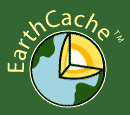This location became a park in December 1993 after a dyeworks previously occupied the site.
Dyeworks park is a busy little place with bbq's, seats, trees and grassed areas. Great for a picnic, relax or play surrounded by many buildings.

The park has been scattered with numerous Basalt boulders. Search the area and read the notes to find the answers to this Earth Cache
Basalt is a common extrusive igneous (volcanic) rock formed from the rapid cooling of basaltic lava exposed at or very near the surface of a planet or moon.

Vesicular Basalt
By definition, basalt is an aphanitic (fine-grained) igneous rock with generally 45-55% silica (SiO2) and less than 10% feldspathoid by volume, and where at least 65% of the rock is feldspar in the form of plagioclase. It is the most common volcanic rock type on Earth, being a key component of oceanic crust as well as the principal volcanic rock in many mid-oceanic islands, including Iceland, Réunion and the islands of Hawaii. Basalt commonly features a very fine-grained or glassy matrix interspersed with visible mineral grains. The average density is 3.0 gm/cm3
Basalt is defined by its mineral content and texture, and physical descriptions without mineralogical context may be unreliable in some circumstances. Basalt is usually grey to black in colour, but rapidly weathers to brown or rust-red due to oxidation of its mafic (iron-rich) minerals into hematite and other iron oxides and hydroxides. Although usually characterized as "dark", basaltic rocks exhibit a wide range of shading due to regional geochemical processes. Due to weathering or high concentrations of plagioclase, some basalts can be quite light-coloured, superficially resembling andesite to untrained eyes. Basalt has a fine-grained mineral texture due to the molten rock cooling too quickly for large mineral crystals to grow; it is often porphyritic, containing larger crystals (phenocrysts) formed prior to the extrusion that brought the magma to the surface, embedded in a finer-grained matrix. These phenocrysts usually are of olivine or a calcium-rich plagioclase, which have the highest melting temperatures of the typical minerals that can crystallize from the melt.
Basalt with a vesicular texture is called vesicular basalt, when the bulk of the rock is mostly solid; when the vesicles are over 1/2 the volume of a specimen, it is called scoria. This texture forms when dissolved gases come out of solution and form bubbles as the magma decompresses as it reaches the surface, yet are trapped as the erupted lava hardens before the gases can escape.
This texture is common in aphanitic, or glassy, igneous rocks that have come to the surface of the earth, a process known as extrusion. As magma rises to the surface the pressure on it decreases. When this happens gasses dissolved in the magma are able to come out of solution, forming gas bubbles (the cavities) inside it. When the magma finally reaches the surface as lava and cools, the rock solidifies around the gas bubbles and traps them inside, preserving them as holes filled with gas called vesicles.

Questions
Q1 The posted coordinates will bring you between the 2 largest rocks in the park. Describe the front (roadside) and the middle of the rock. Does it differ?
Q2 Now look at the back of these 2 main rocks. What colours do you see in them and how do the differ to the middle and front of the rock?
Q3 Stage 2 will bring you a few meters further into the park. What are the 2 differences in the small gathering of rocks here.
Q4 How is the vesicular texture formed?
Once you complete the EarthCache requirements you can post your find without delay, as per the EarthCache guidelines. You will also need to verify your find by sending me a message and provide your answers to the questions.
For a link to my profile, click here - Na'wal
Thanks for visiting this Earth Cache. Hope you enjoy the location.

Feel free to attach photos to your log (optional)

References ~ Geology.com, Stonnington City Council & Wikipedia